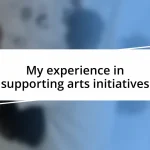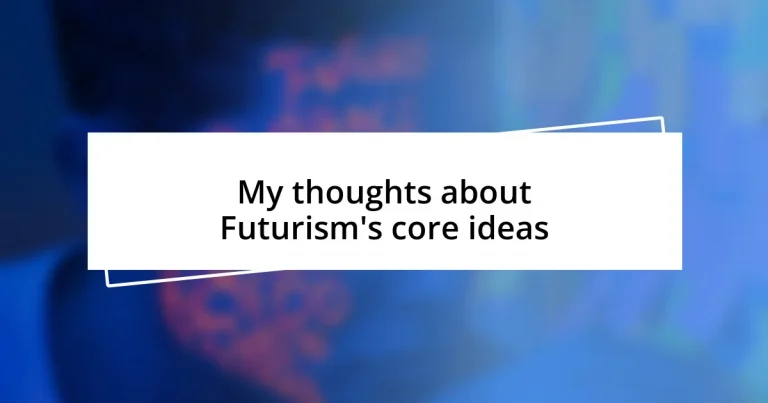Key takeaways:
- Futurism intertwines technology, art, and society, urging a progressive view of innovation and creativity.
- The movement emphasizes modernity, speed, and the rejection of tradition, encouraging new forms of artistic expression.
- Criticism of Futurism includes concerns about neglecting human experience and a lack of diverse voices in its narrative.
- Future trends in Futurism point towards sustainability and ethical discussions, balancing technological advancements with human values.
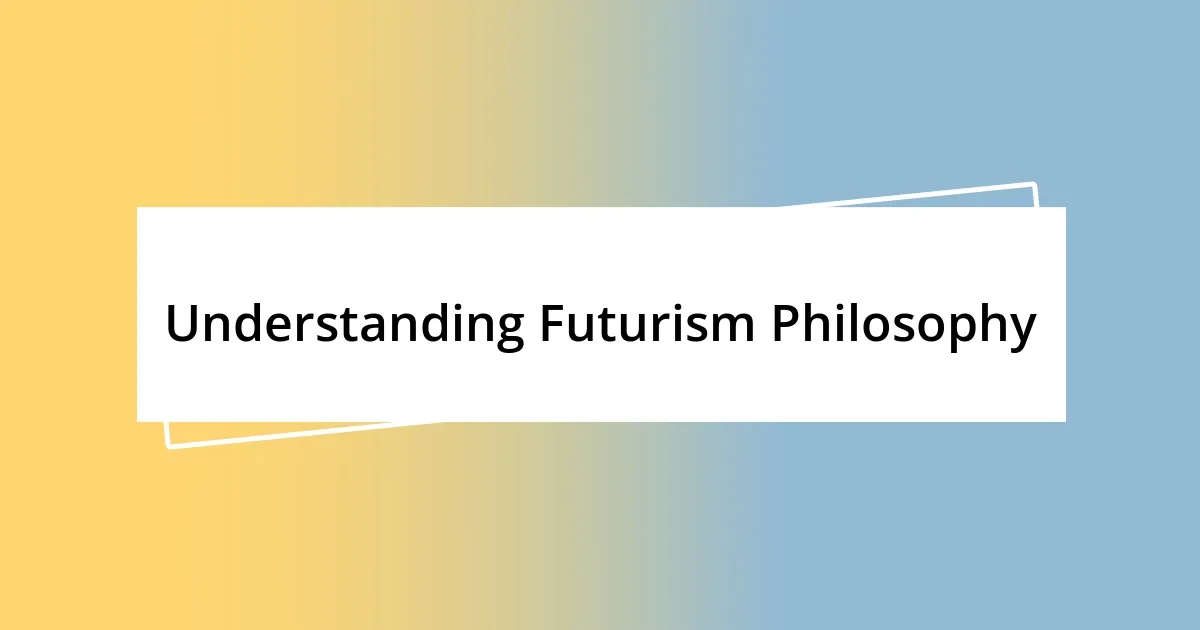
Understanding Futurism Philosophy
Futurism, at its core, challenges the conventional by marrying technology with art and society, pushing us to envision a world reshaped by innovation. I remember the first time I stumbled upon a Futurist painting—its dynamic lines and vibrant energy left me both exhilarated and contemplative. How does embracing such radical ideas influence our perception of progress and creativity?
One of the striking aspects of Futurism is its unabashed enthusiasm for modernity and speed. As I reflect on my experiences in rapidly evolving cities, I can’t help but feel invigorated by the pulse of technology around me. The rush of new ideas seems almost palpable; aren’t we all yearning for that exhilaration in our everyday lives?
Moreover, Futurism pushes us to consider the implications of technology on our existence. I often ponder how advancements in artificial intelligence could redefine not only work but also our relationships. It’s fascinating, isn’t it? To think about how Futurism dares us to embrace change, while simultaneously challenging us to retain our humanity in this ever-accelerating landscape.

Key Principles of Futurism
The key principles of Futurism revolve around a celebration of movement, technology, and the avant-garde. When I think about these principles, I remember a walk through a contemporary art exhibit that featured pieces blending traditional painting with digital elements. It struck me how these artworks captured not just images but the very essence of our fast-paced world. This merging of the organic with the mechanical highlights a Futurist belief that technology can lead to new forms of expression and understanding.
- Embrace of Modernity: Futurism thrives on the idea that progress is essential. I often feel this in my daily life—each innovation opens doors to new experiences.
- Celebration of Speed and Motion: The emphasis on dynamism can be exhilarating. Last summer, while biking through an urban landscape, I felt that rush of wind and fleeting views embodying the very spirit of Futurism.
- Rejection of Tradition: Futurists sought to break away from the past. Reflecting on my own journey in creativity, I find that letting go of traditional constraints allows for true innovation.
- Focus on Technology’s Role: The movement urges us to engage with machines as partners. My own experience with new technology has often reshaped how I view creativity and collaboration.
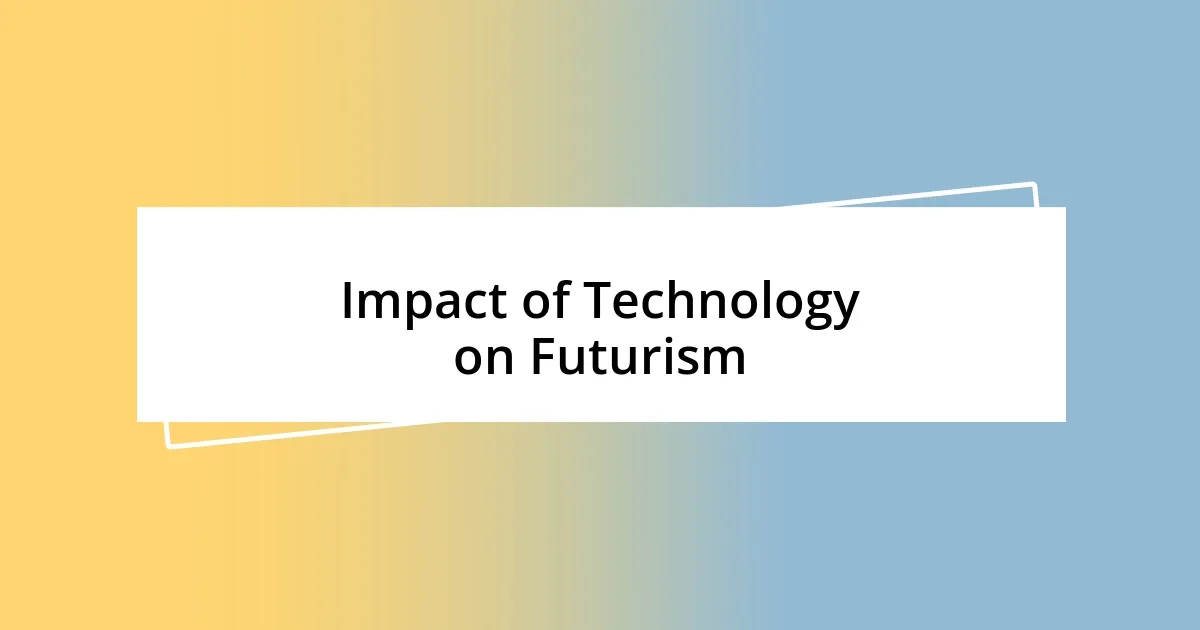
Impact of Technology on Futurism
The impact of technology on Futurism is profound and multifaceted. I observe how every new gadget or platform seems to ignite a wave of creativity. For instance, when I experimented with virtual reality, it felt like stepping into a Futurist piece—immersive and transformative. Technology isn’t just a tool; it reshapes our imagination and pushes the boundaries of what art can be.
In my view, the speed at which technology evolves mirrors the very essence of Futurism. I recall an evening spent at a digital art show where innovative projections created a dazzling experience. The artwork was not fixed but changing, much like our rapidly developing world. It evokes a question—how do we keep pace with the artistic expression that can arise from such technological advancements?
Moreover, the relationship between technology and Futurism prompts reflection on our societal values. I remember discussing with friends how automation could influence our lives. As we explored this topic, I felt a spark of worry mixed with excitement. Could we find a balance between embracing technological progress and nurturing our human connections? This tension enhances the Futurist dialogue, compelling us to rethink our future actively.
| Aspect | Implication |
|---|---|
| Technological Innovation | Drives new creative expressions |
| Speed of Change | Challenges artists to adapt |
| Societal Reflection | Prompts re-evaluation of human values |

Cultural Aspects of Futurism
The cultural aspects of Futurism reflect a profound yearning for innovation and change. I often think about the first time I attended a Futurist-themed performance art show. The energy in the room felt electric, with performers embodying speed and aggression, echoing the essence of urban life. This visceral experience highlighted how Futurism not only celebrates technological advancements but also offers a space for exploring human emotions in an increasingly mechanized world.
At a more personal level, I find that the Futurist ethos has influenced my view on everyday culture. When I visit cities, it’s the modern architecture that captures my attention—those bold lines and dynamic forms seem to tell stories of movement and progress. These elements make me think: how does our environment shape our perceptions and aspirations? I realize that embracing these modern cultural expressions can foster a collective identity built around innovation and adventure.
Furthermore, the emphasis on breaking free from tradition resonates deeply with me. I can recall a discussion with a friend about how the constraints of conventional art forms felt stifling. This led us to create our own fusion of music and digital art. The joy of experimentation was liberating, highlighting that Futurism isn’t just a movement; it’s a mindset. It encourages each of us to redefine our boundaries and envision a future where culture evolves alongside technology. Isn’t that an exciting prospect?
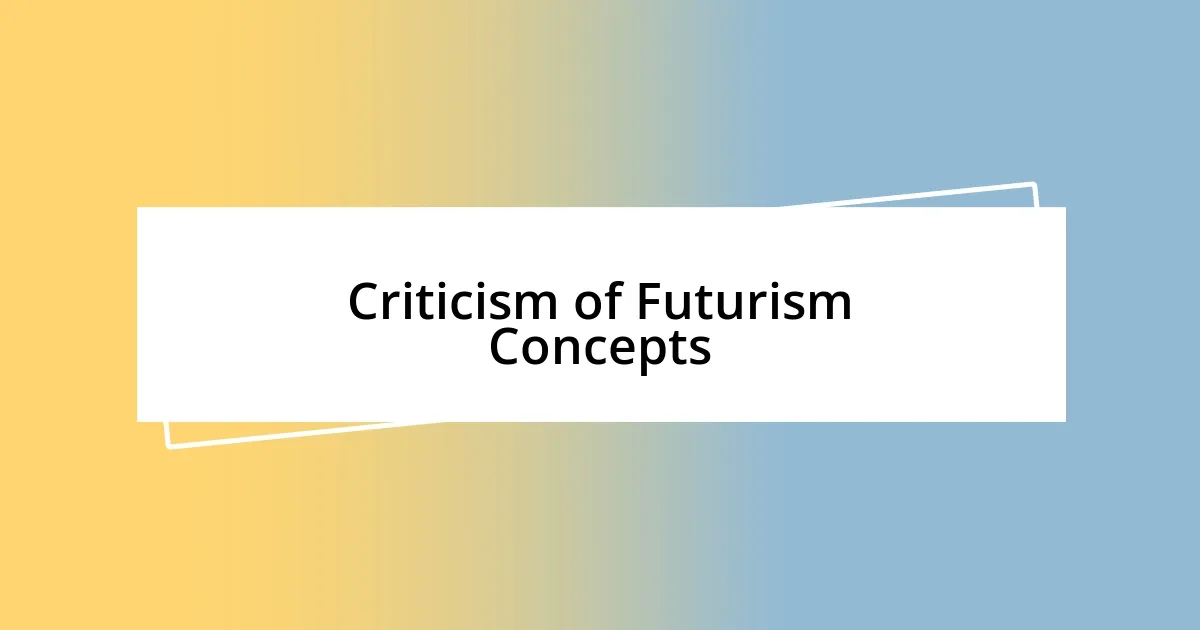
Criticism of Futurism Concepts
Critics often argue that Futurism’s fixation on technology risks overlooking the human experience. I remember chatting with a colleague who pointed out that in our rush towards innovation, we sometimes neglect the emotional and psychological effects of rapid change. It’s a valid concern—how often do we stop to consider the implications of living in a hyper-digital world?
Another critique I’ve encountered involves the movement’s often limited representation of diverse voices. During a discussion at an art symposium, an artist shared her frustration about how traditional Futurist narratives frequently prioritize certain perspectives. This disparity raises important questions: Can we genuinely innovate if we silence voices that could enrich the dialogue? It makes me ponder whether true Futurism can thrive without inclusivity.
Moreover, the aggressive valorization of speed in Futurism sometimes comes at a cost. I recall reading a thought-provoking article where the author lamented that the relentless push for progress can lead to burnout and disconnection. When did we accept that constant acceleration is synonymous with success? This concept has led me to reflect on my own life—am I part of the solution, or am I contributing to this problematic chase? These concerns encourage a vital reassessment of Futurism’s core ideas and their real-world relevance.
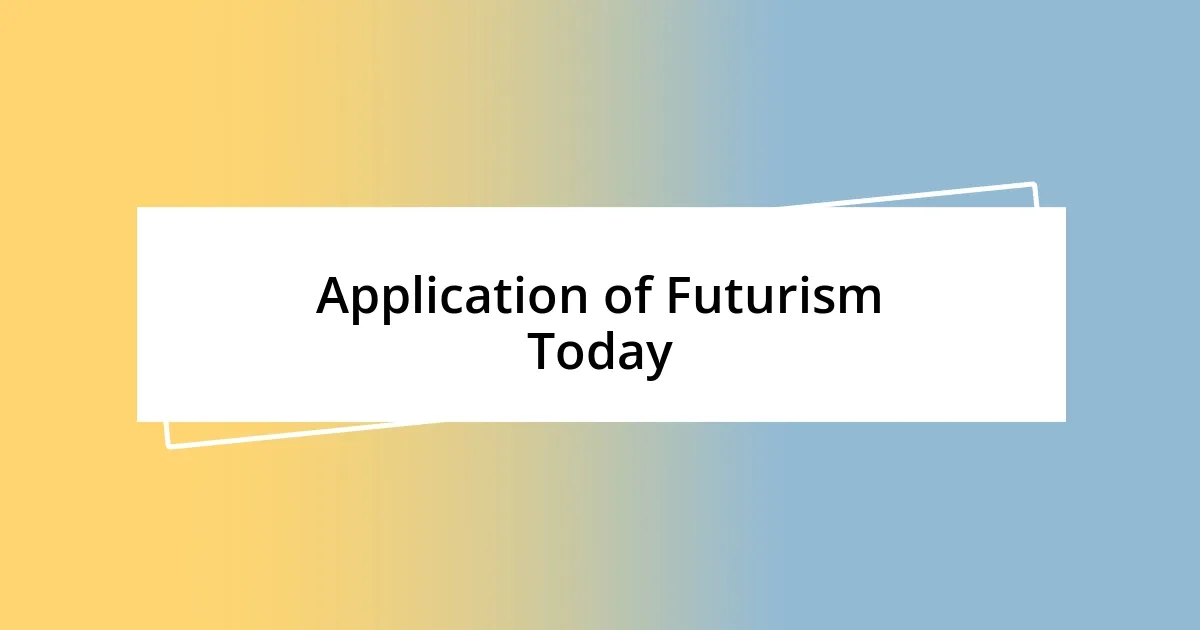
Application of Futurism Today
The application of Futurism today manifests in various domains, particularly in design and technology. I once visited an exhibition showcasing cutting-edge urban designs that were inspired by Futurist principles. The buildings leaned boldly into the future with their sweeping curves and smart materials, making me wonder if we could live in harmony with our digital environments. How do these advancements not only redefine our skylines but also our daily experiences?
In the tech world, Futurist ideas are reflected in innovations like artificial intelligence and virtual reality. I can’t forget the exhilaration I felt trying a VR experience that simulated being in a bustling cityscape. It was exhilarating yet slightly overwhelming, reminding me that while technology can transport us to astounding places, it can also blur the lines of reality. This duality raises a crucial question: are we enhancing life through technology, or are we becoming estranged from our lived experiences?
On a more personal note, I find myself drawn to Futurist startups that challenge conventional thinking. I recently attended a pitch event where entrepreneurs presented ideas for sustainable living through smart technology. Listening to their visionary concepts, I felt a surge of hope and excitement. It dawned on me that Futurism today isn’t just about speed; it’s about responsible innovation. Can embracing these ideas lead us to a future that balances ambition with depth? That’s the challenge we face as we apply Futurism in today’s rapidly evolving landscape.
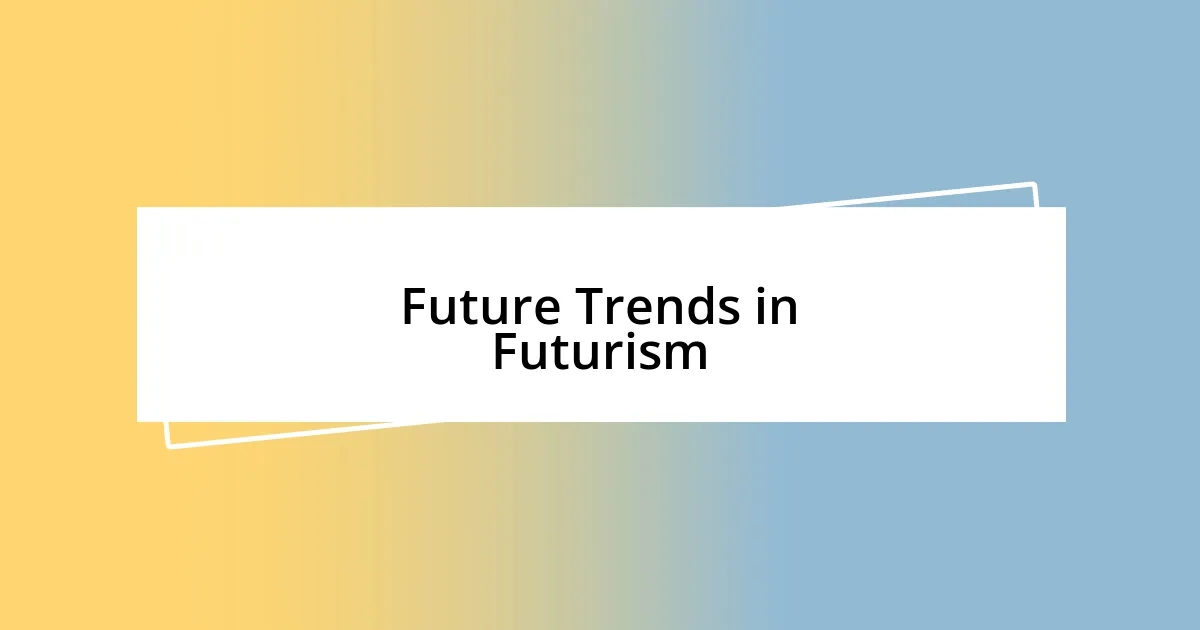
Future Trends in Futurism
Futurism is evolving, and I feel there’s a remarkable shift happening towards sustainability. I recently watched a documentary that showcased innovative green technologies emerging from Futurist thinking. It was inspiring to see how eco-conscious designs are becoming integral to our future. This trend makes me wonder: will we look back and see this moment as a pivotal point where technology and nature began to harmonize?
Another intriguing trend I’ve noticed is the rise of digital art and virtual galleries, which blend creativity with technology. I remember attending a virtual exhibition where I experienced art in a way I never thought possible—floating through the pieces as if I were in a dream. It struck me then how digital spaces can foster new forms of connection and expression. So, could this be the future of art, where boundaries dissolve? It certainly feels like it, and I can’t help but feel excited for what this means for artists and audiences alike.
Moreover, I’m fascinated by how Futurism is fostering discussions around ethics. For instance, at a recent panel discussion I attended, experts debated the moral implications of our growing reliance on technology. Listening to their varying perspectives stirred something within me—how do we navigate this complex landscape without losing our humanity? This ongoing dialogue about ethics, particularly regarding AI and data privacy, signals that the evolution of Futurism isn’t just about what we can do but also about what we should do. It adds a rich layer to our understanding of the future.



